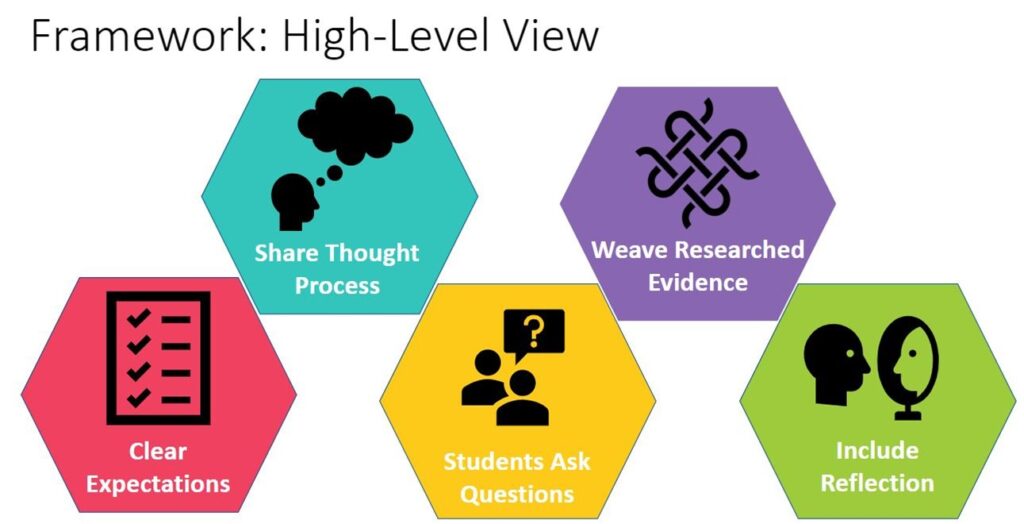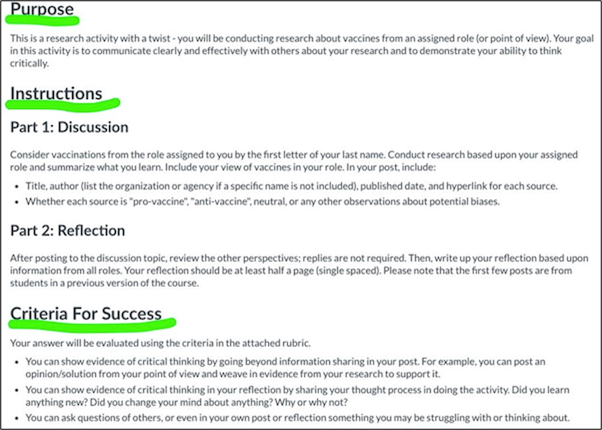Faculty often use discussion strategies to engage their students and push them into higher levels of learning. But many instructors we have talked to have noticed that discussions can often feel like busywork or small talk. Providing structure is one way to elevate discussions from surface-level information sharing to higher levels of knowledge construction (Darabi, 2011).
How do you create that structure?
From our research into creating more engaging online discussions we developed the Framework for Student Engagement and Critical Thinking in Online Discussions(Berry & Kowal, 2022). This five-component framework guides students into deeper, more meaningful online discussions and encourages them to engage with both the content and their peers. Let’s take a closer look at each component and see how you can incorporate this framework into your discussions.

Component 1: Include detailed instructions and set clear expectations
While all faculty provide students with discussion instructions, often they do not go far enough to encourage critical thinking. For example, we can enhance a prompt that asks students to participate in the activity (how often to post and reply) with information about why we are having the discussion (purpose statement) and specifics on how to be successful, as in the instructions below:

Component 2: Ask students to share their thought process
The next framework component invites students to share their thought processes in their posts. This is comparable to the think-aloud process, which you might already be using in your courses, or to showing your work, like when solving a math problem. Urging students to share their how or why they might have arrived at the answer or conclusion can uncover more detail and depth, which, in turn, can create more opportunities for meaningful discussion.
For example, students discussing a programming problem on the discussion board would not only provide solutions but also explain why they proposed their answer; students working on a case study in a management course would be prompted to share not only their opinions or solutions but also how they arrived at them. We are asking students to make their thinking visible, not just their solutions. The following is an excerpt taken from a student post showing their thought process as they think about their overall body health and wellness:
[The article] prompted us to think about moments in our lives when our body was giving us hints and signs that our health as a whole was out of balance, was so poignant and such a familiar pattern that I find myself in often. When I reflect on a recent illness, I can see how my body was giving me hints that I was rundown, burned out and running on fumes from having several challenges I was juggling all at once. Studies show the impact of stress on the body and had I come across the Whole Health Cairn sooner, I may have been able to identify areas in my life that needed attention to curb illness. I think her talk is powerful, in that it forces us to look at health and wellbeing in a bigger way.
Component 3: Tell students to ask questions in their posts to prompt more discussion
The third framework component asks students to pose questions to invite more discussion with their peers. Asking students to probe deeper and include questions or share reflections in their posts can uncover areas they may be struggling with or thinking about. Include language like the following in your instructions: “Ask questions of others in your post or reflect on something you may be struggling with or thinking about.”
By directing students to do this, you will invite others to join the conversation and allow students to engage with both the content and each other. Using this technique, you may even notice the discussion includes elements of problem solving and critical thinking, which are strong indicators of the students digging deeper into a topic. It can be rare to see students asking questions in their posts. But when students post questions, it opens the door for others to join the discussion.
For example, students discussing optimal health and well-being might pose questions such as “How can I best design a wellness program to ensure others will have the time and energy to use it?,” “How does technology impact an individual’s health and wellness?,” or “Why does the environment play a role in one’s overall well-being?” Prompting students to pose questions to their peers not only invites conversation but also creates an opportunity to share solutions.
Component 4: Encourage students to weave evidence into their posts
You may have noticed that when students are directed to use sources within a discussion, they often merely post a link at the bottom of their post without referencing or citing it in the body of the discussion. This framework component instructs students to weave evidence or sources into the body of the discussion to allow you and others to quickly identify where or how they learned the information. While you want to encourage students to form original thoughts and opinions, you also want them to be able to support their thinking with evidence. To urge students to cite their source of information within their discussion itself, include language in your instructions such as “Post an opinion or solution from your point of view and weave in your found evidence to support it” or “Remember to reference the resources used to provide the evidence.”
For example, students discussing individuals whom they think portray leadership or powerful influencer characteristics would state their claims while weaving in reliable sources to support their thinking. An example post might begin, “Oprah Winfrey comes to mind when I think of powerful influencers because according to Evans (2016), she exhibits the following characteristics . . .” While we are asking students to share their personal thoughts and opinions, we are also asking them to identify and support their reasoning.
Component 5: Ask students to reflect on the activity
It can be powerful to ask students to reflect on how a learning experience might have changed their thinking. Adding a reflection component to your discussions can illuminate where construction of new knowledge has occurred. We recognize that including this component will take more time for students, but it is helpful for them to be able to synthesize not only their thoughts but also the thoughts and perspectives they gain from others. In a discussion post, you can include a reflection component with questions like these to uncover any kind of transformation that has happened during the activity: “Did you learn anything new? Did you change your mind about anything? How have you deepened or expanded your thinking?”
For example, students discussing their personal sense of purpose and developing a strategy to help them achieve their goals might include statements such as “I never thought of it this way; maybe I need to go in a different direction or involve myself in a new community” or “I never thought of myself being in this particular role; perhaps this is something I need to consider if I do want to pursue this in more depth.” Encouraging students to reflect on the activity could lead them to create new connections to both the content and to themselves.
References
Berry, L. A., & Kowal, K. B. (2022). Effect of role-play in online discussions on student engagement and critical thinking. Online Learning, 26(3), 4–21. https://doi.org/10.24059/olj.v26i3.3367
Darabi, A., Arrastia, M. C., Nelson, D. W., Cornille, T., & Liang, X. (2011). Cognitive presence in asynchronous online learning: A comparison of four discussion strategies. Journal of Computer Assisted Learning, 27(3), 216–227. https://doi.org/10.1111/j.1365-2729.2010.00392.x
Kristin Kowal is a senior instructional designer and Laurie Berry is an instructional designer at the University of Wisconsin Extended Campus.






